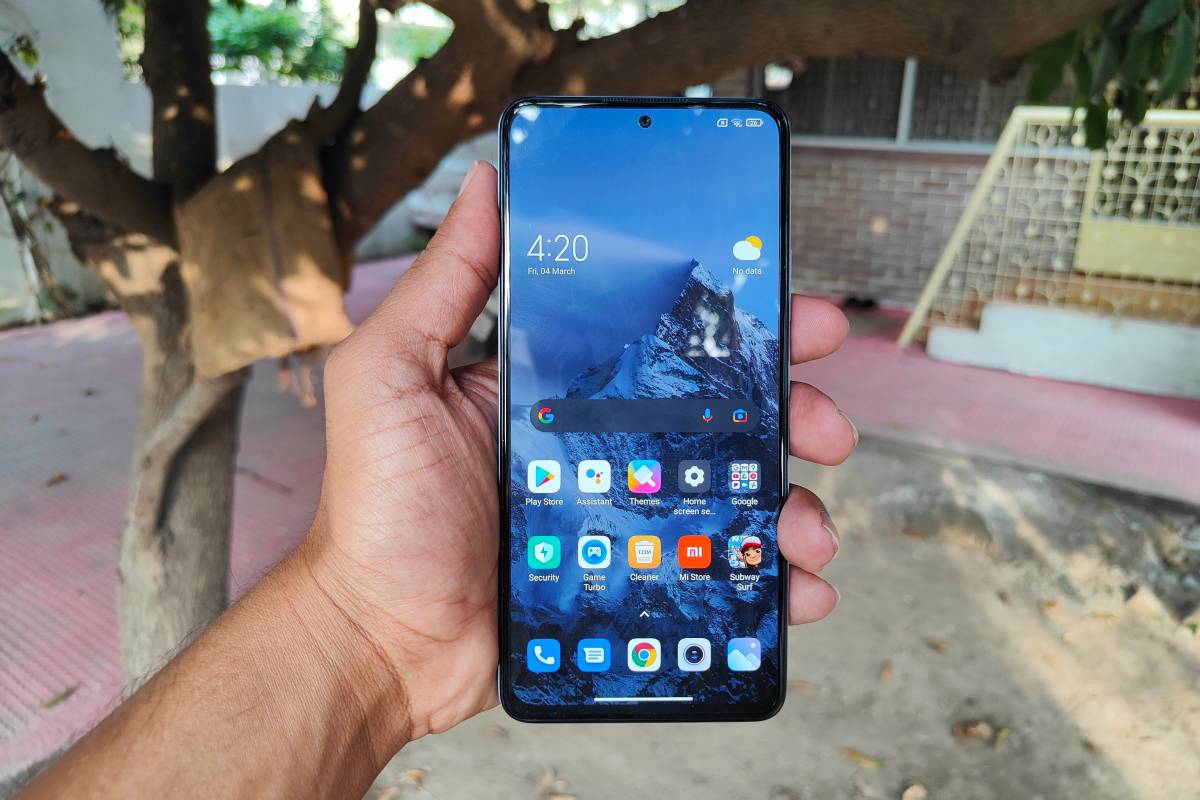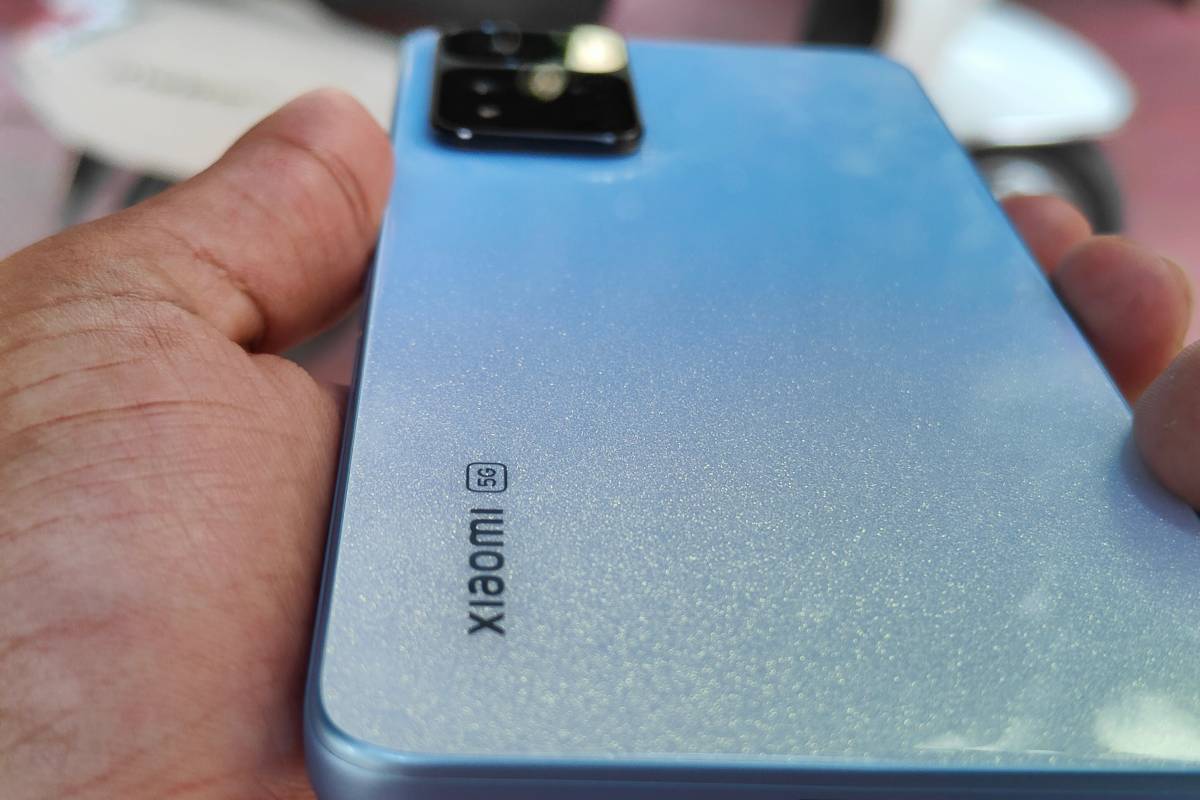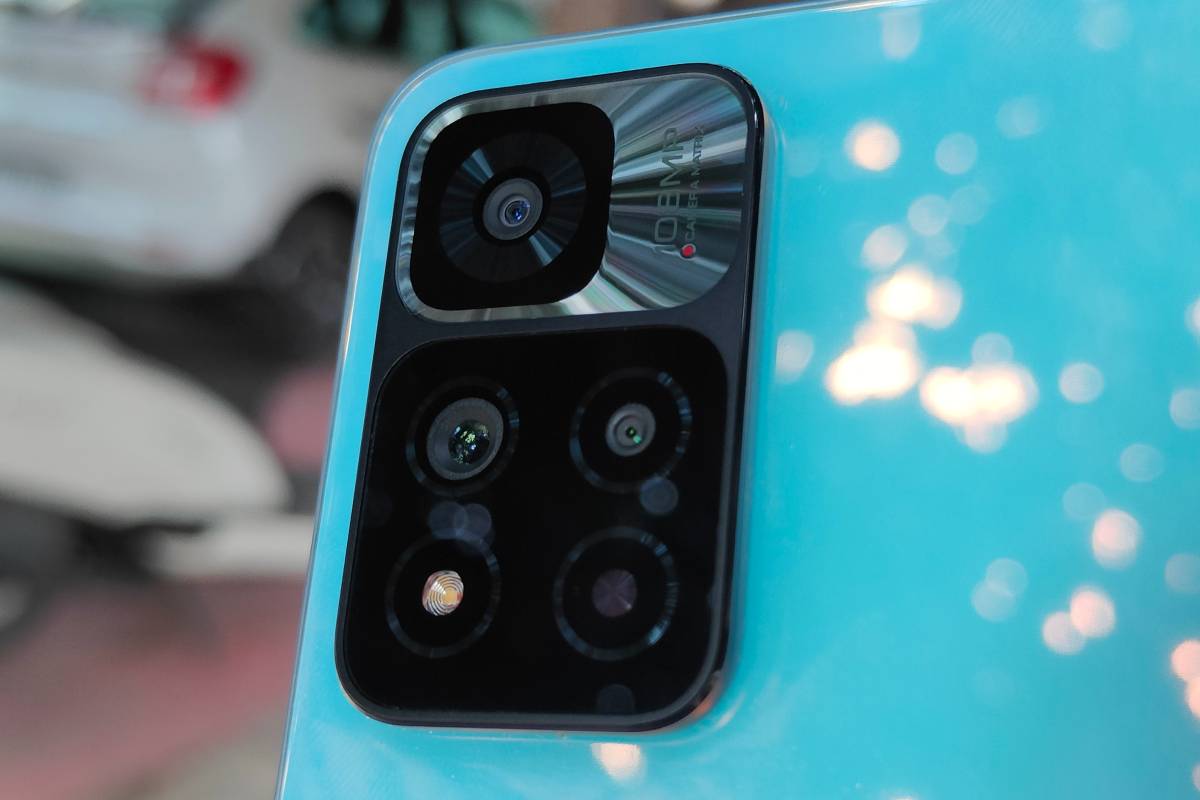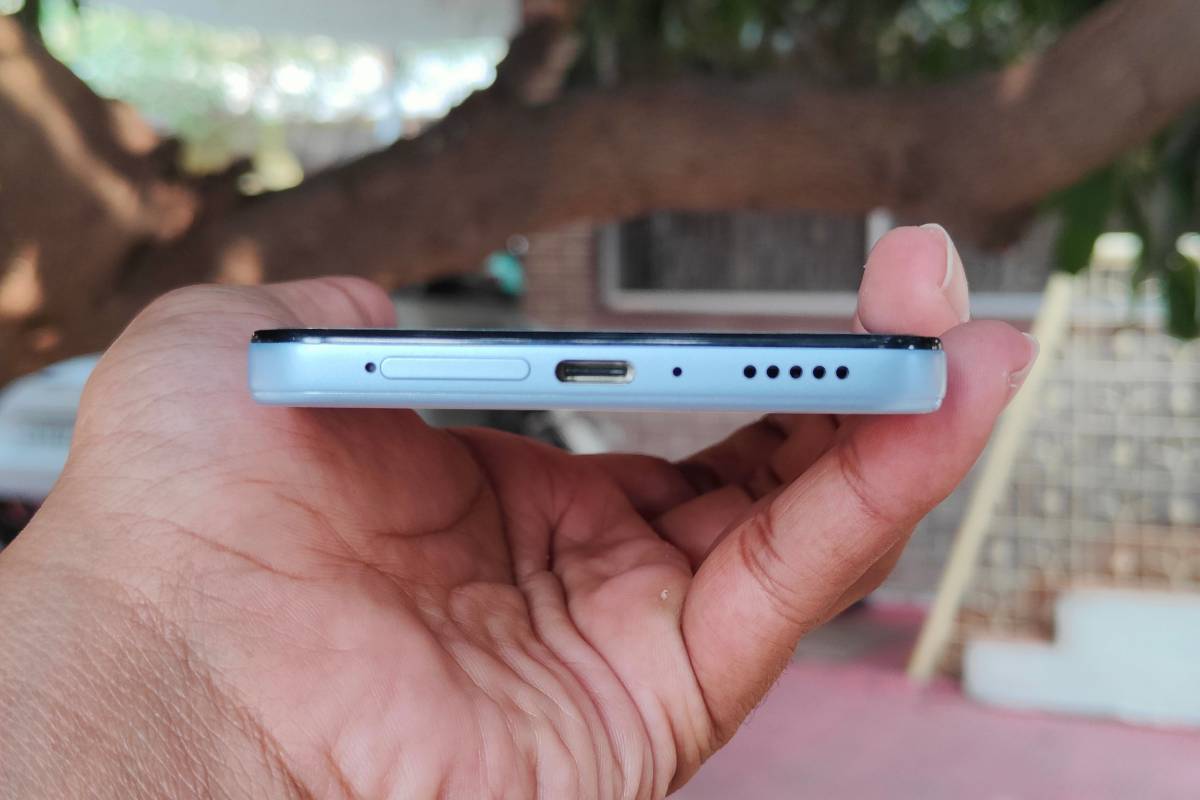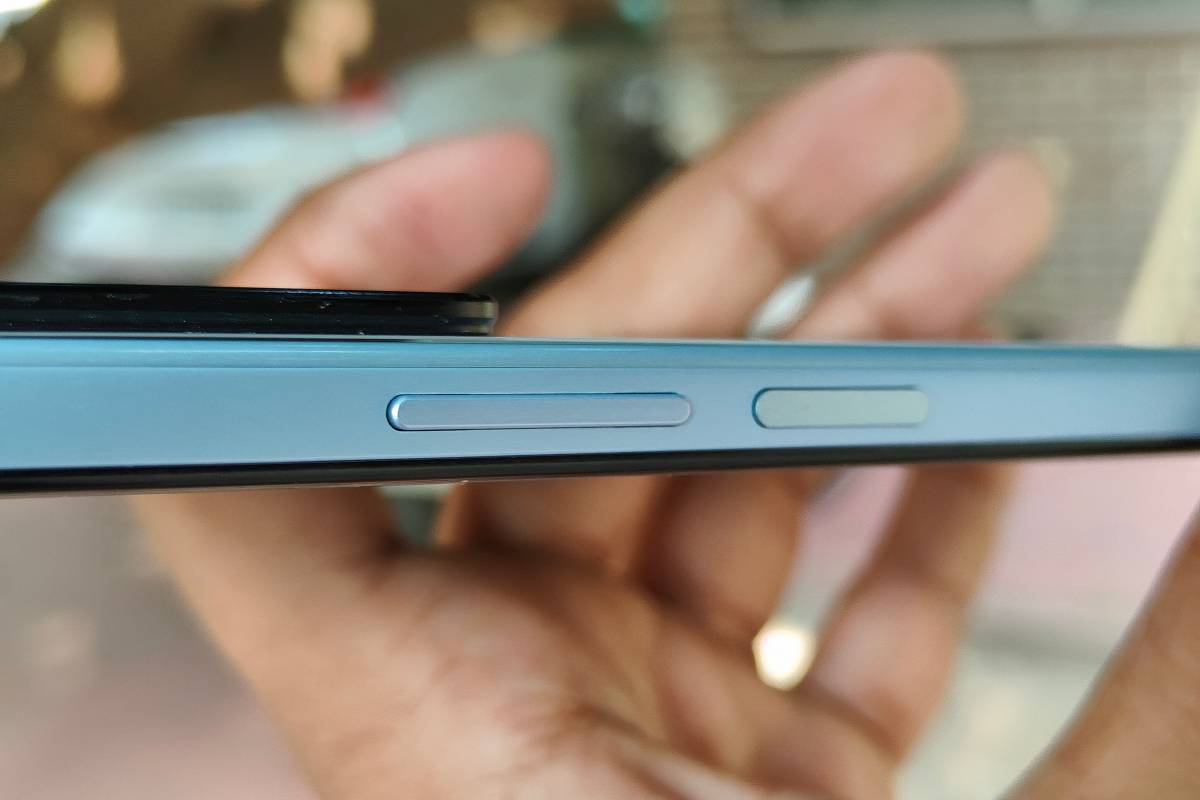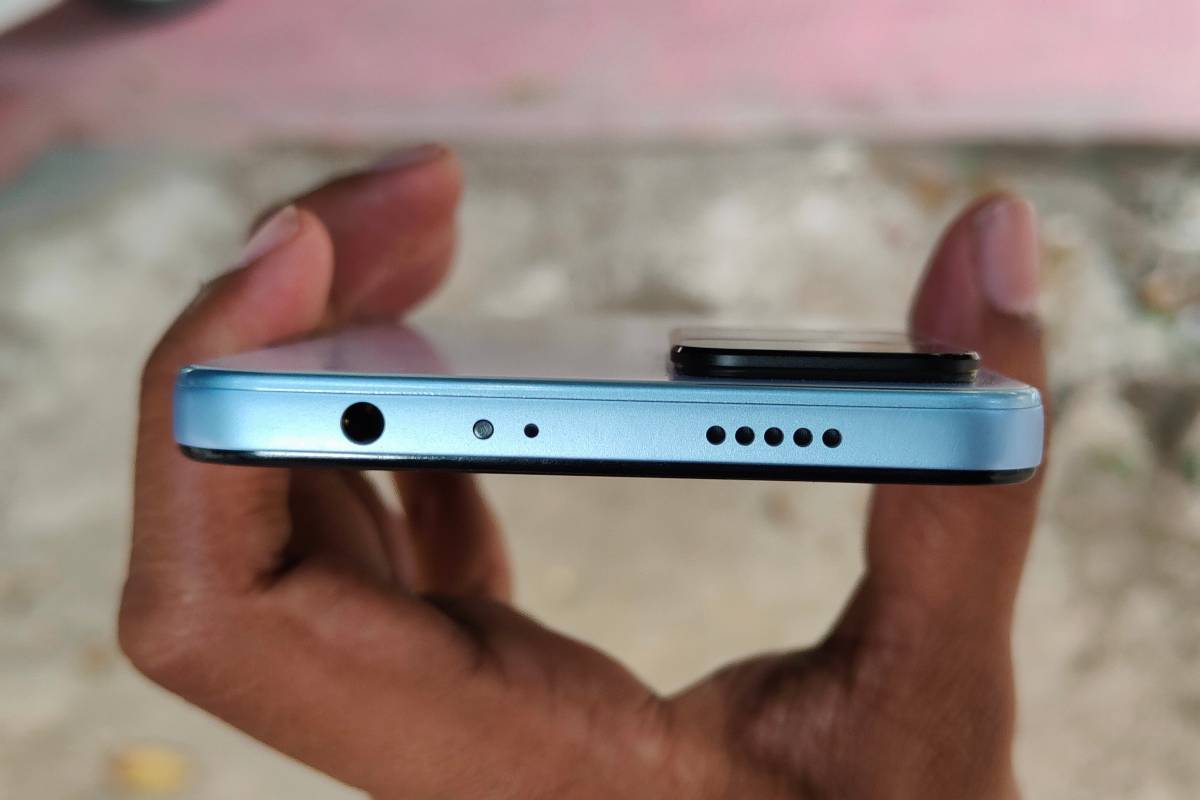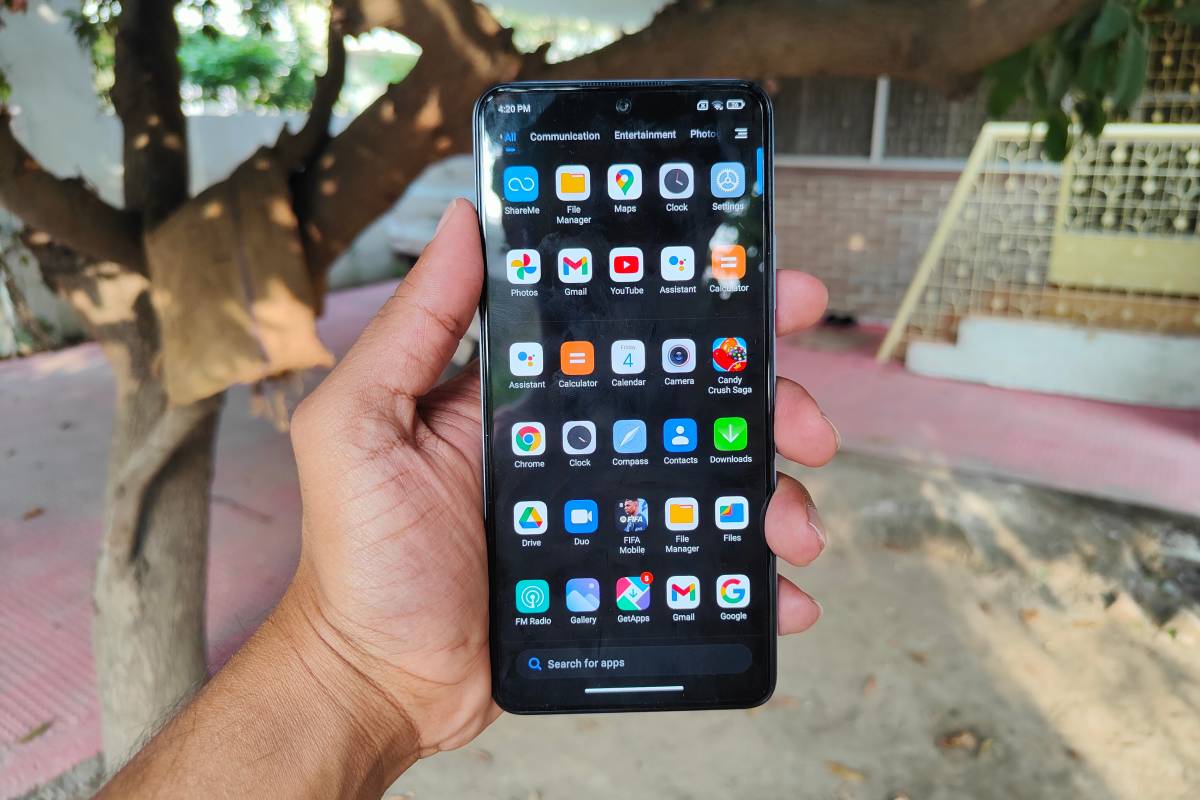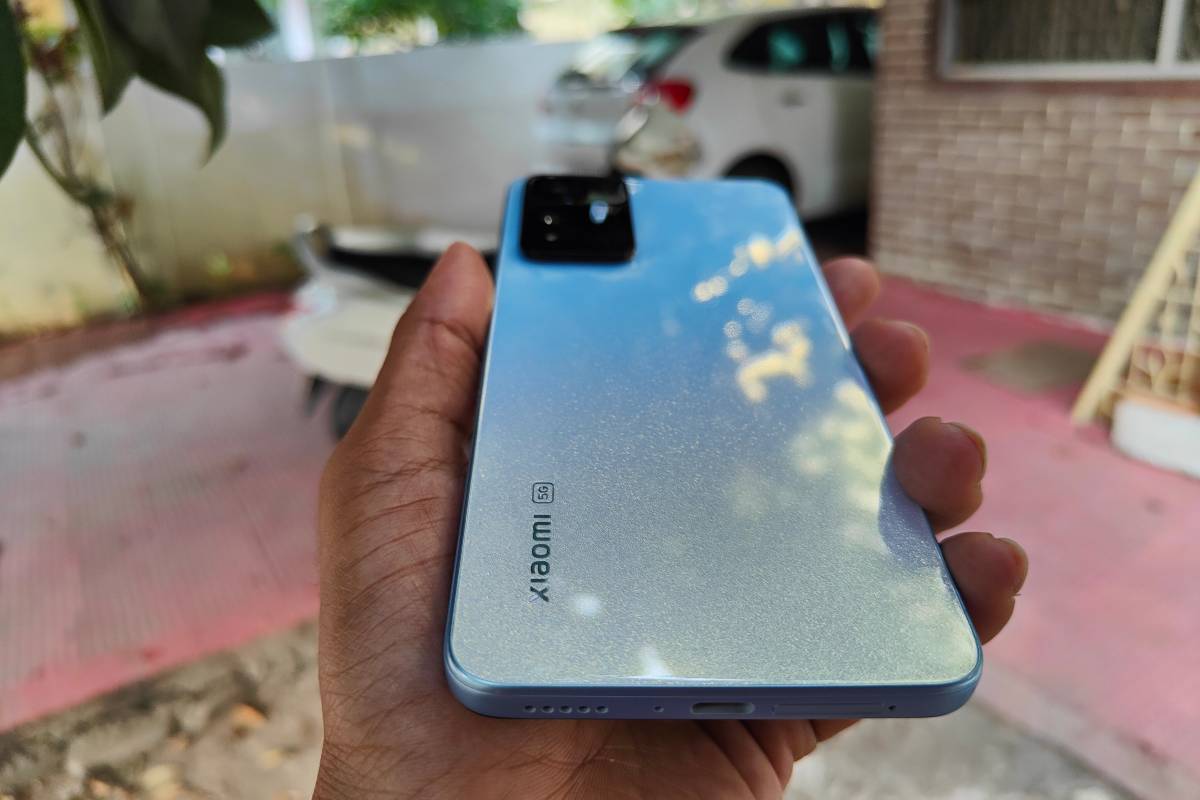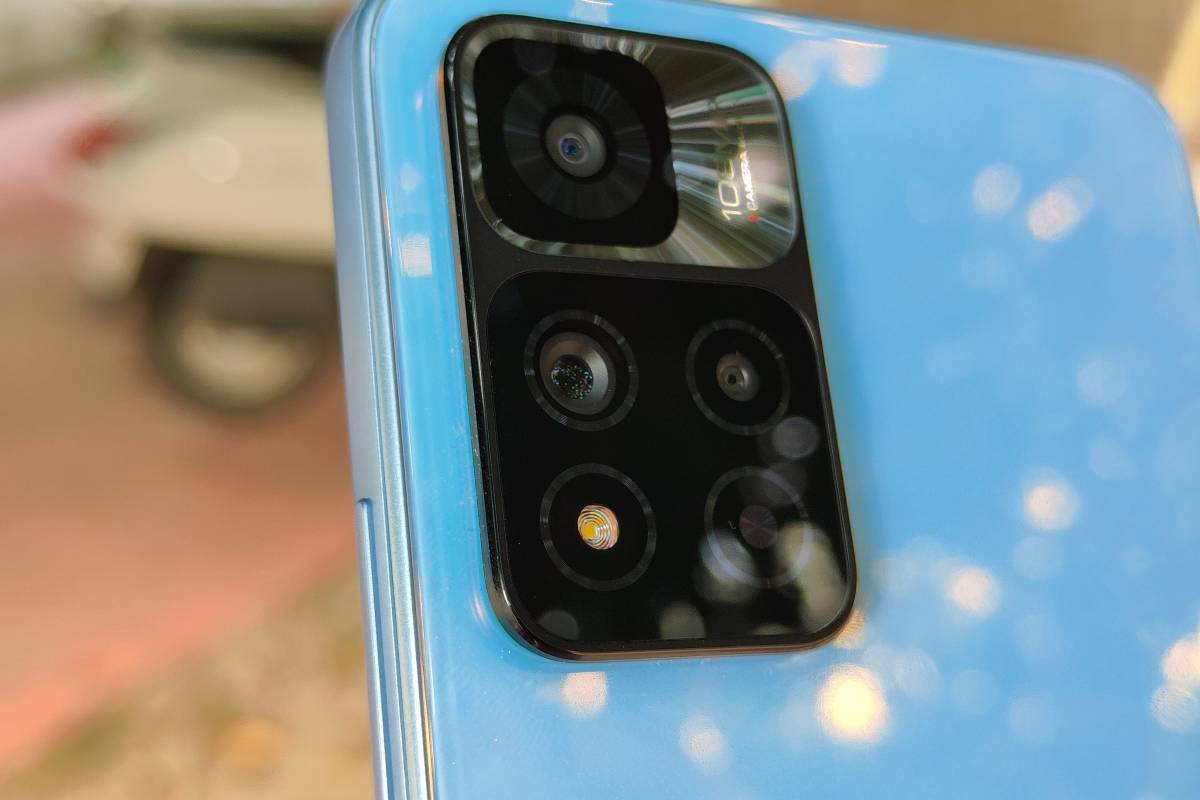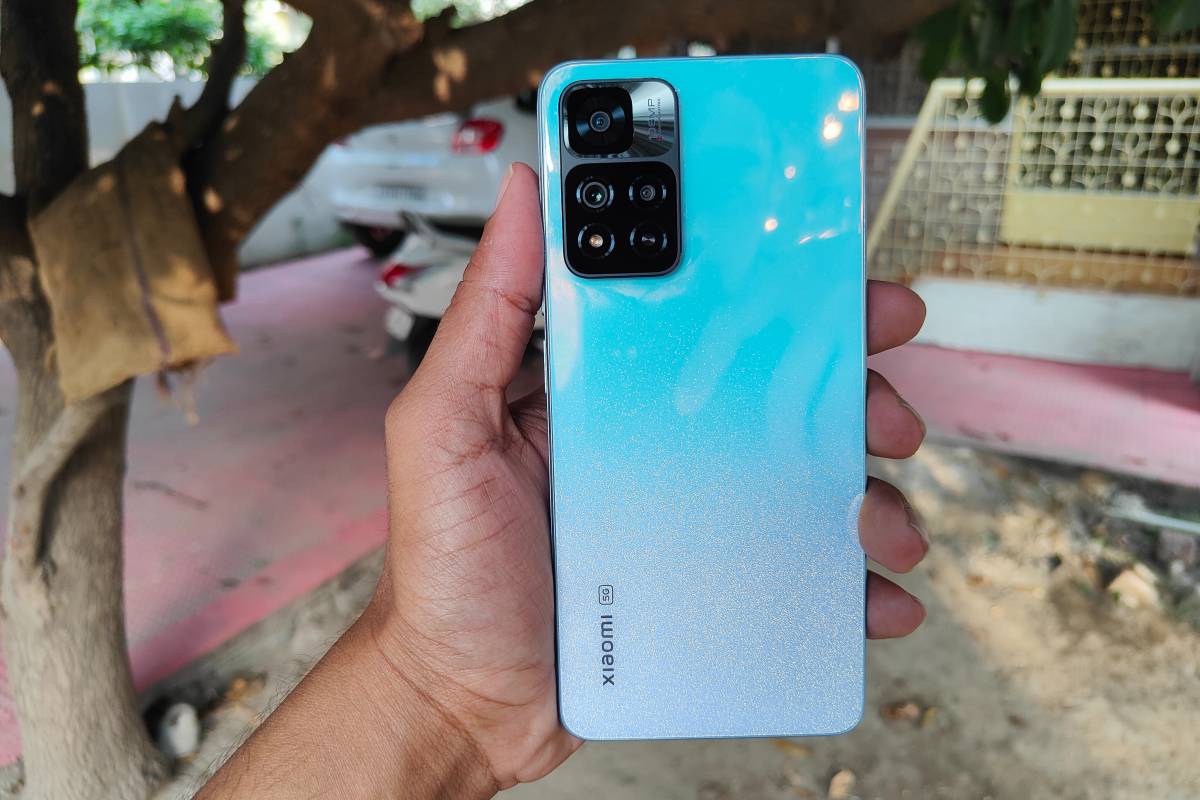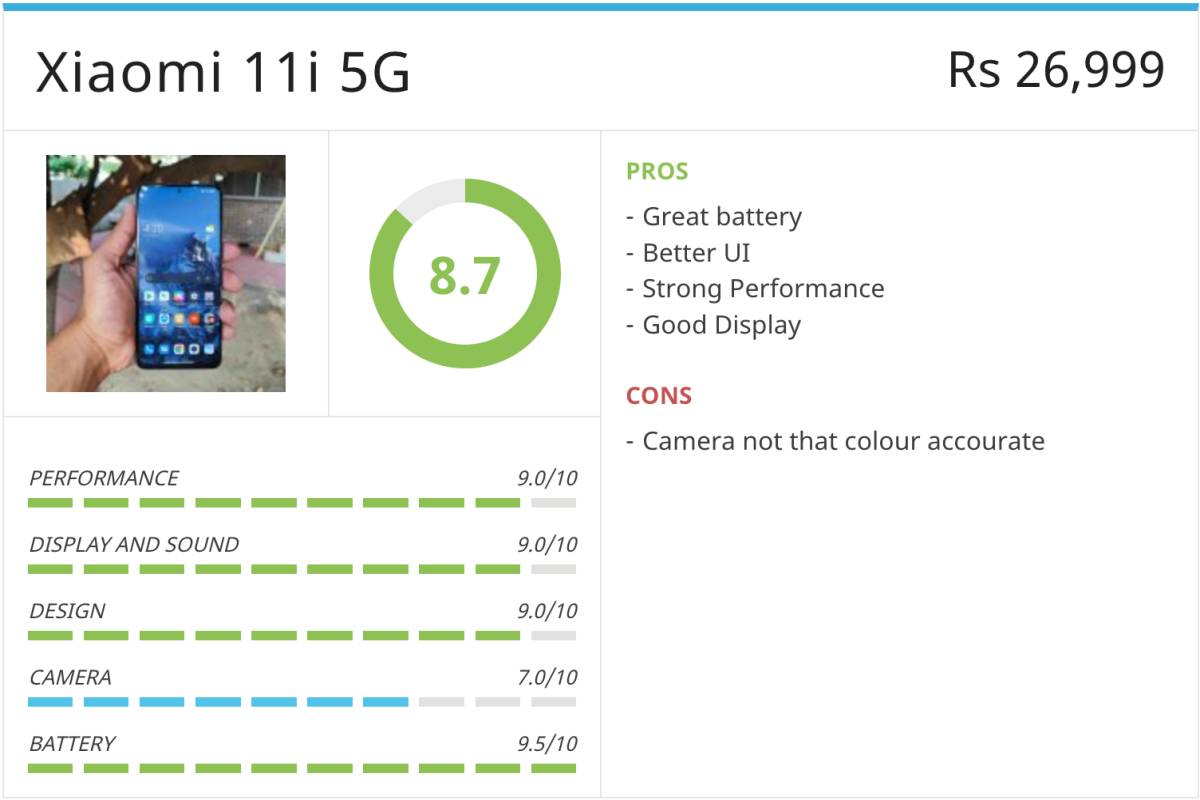Xiaomi 11i 5G Review: Body and Design
Xiaomi is one of the Chinese OEMs (original equipment manufacturers) which has continuously launched smartphones with unique colour combinations and finishes. It is a treat to watch the Xiaomi 11i 5G glass back with the Pacific Peal colour. I am sure the other colour variants of the smartphone might be equally unique. It is available in a total of four colours in India — Pacific Pearl (the one I am posting the images of), Camo Green, Purple Mist, and Stealth Black. The device weighs 207 grams and thus will fall in the slightly heavy category. Its dimensions are 163.64mm x 76.19mm x 8.34mm. It might feel a little big to operate from a single hand for many users.
Regardless, the device looks very attractive. The camera bump at the rear is stylish and bold. You will definitely need a cover if you are going to keep it on the table with the rear cameras at the bottom (facing the surface). That is not a problem as Xiaomi provides one free silicone cover right inside the box. There are flat edges at the sides, and the corners are slightly rounded. From the front, it looks like an average mid-range device with a punch-hole cutout at the top centre for housing the selfie sensor.
The Xiaomi 11i 5G has two stereo speakers - one at the top and one at the bottom. You will also find the SIM tray and the Type-C port at the bottom. There’s absolutely nothing on the left side of the device. The volume buttons and the power button are on the right side.
Xiaomi has placed the power button at the precise spot where most people would have their thumbs. The Xiaomi 11i 5G’s fingerprint sensor is integrated into the power button. I must say, it is a very fast and responsive fingerprint mechanism. It is almost instant.
But wait, there’s more! One thing that a lot of Indians are going to praise Xiaomi for is including a 3.5mm audio jack on the device. It is present at the top and will allow users to plug wired earphones and aux cables for playing music. Almost every mid-range phone in the market today lacks a 3.5mm audio jack. It is also worth mentioning that the chin and the bezels at the side are quite thin, almost the same as the OnePlus Nord 2 5G’s chin. Now let’s talk about how the device performs overall.
Xiaomi 11i 5G Review: Display and Sound
Many Indians are crazy for the large and long displays. I am not one of those people; thus, I found the display of the device a little larger than my liking. The Xiaomi 11i 5G has a 6.67-inch FHD+ (2400x1800 pixels) AMOLED display with support for up to 120Hz refresh rate and a touch sampling rate of up to 360Hz. The peak brightness can go up to 1200nits, which is very bright for any display in a mid-range device. You should not have a lot of difficulties in watching something on the screen under sunlight. Further, there’s Gorilla Glass 5 on the top for additional protection. Xiaomi 11i 5G comes with support for Sunshine screen, Reading Mode, and 360 degree light perception. Because it can support 120Hz refresh rate, the display experience is super smooth. I have been using the device in Dark Mode, and it is a super fine experience overall. The display is very responsive too and hasn’t lagged in the last month I have used it for. The colour looks very vibrant and balanced on most of the high-quality videos I see on this device. Gaming would also be a smooth experience because of the 360Hz of touch sampling rate support. Even the audio is something that I can’t skip to appreciate. As mentioned above, the Xiaomi 11i 5G has a dual-stereo speaker system. Whether you are listening to a song or streaming a video from an over-the-top (OTT) platform, you are going to get a great sound experience. Note that it is also important that the quality of the video and audio should be good in order to get a good experience out of it. The transitions and animations are very basic and smooth, and they won’t bother you ever because they are very clean. Overall, it is safe to say that you are going to have a good enough experience watching anything on the Xiaomi 11i 5G.
Xiaomi 11i 5G Review: A Stunning Performer for the Price
Xiaomi 11i 5G is a mid-range device that is built for performance. I have played multiple games on the device, including Subway Surfers, Battlegrounds Mobile India, and more. It worked decently even when the playtime touched almost two hours, which is what I like to see on a smartphone. The device is powered by the MediaTek Dimensity 920 SoC coupled with up to 8GB of RAM and 128GB of internal storage. The Xiaomi 11i 5G is one of the most responsive smartphones today in the Rs 20,000 to Rs 30,000 range. If you are a gamer, this mid-range smartphone can be your perfect partner. The chipset is capable enough of handling multitasking. Though I do wish there was a 12GB RAM variant available in India. I will be really honest here. I didn’t like MIUI much. Even today, I would prefer ColorOS or OxygenOS more when it comes to Chinese OEMs. While that’s a subjective thing, I would like to point out why MIUI wasn’t and still isn’t my go-to OS. With MIUI, earlier, there were a lot of apps that you couldn’t uninstall from your device. But now, with the MIUI 12.5 (based on Android 11), Xiaomi has paid special attention to making its skin not only lighter and more efficient but also the number of apps that used to come pre-installed and couldn’t be uninstalled has reduced significantly. There are still ‘GetApps’ offered by Xiaomi, which can’t be uninstalled. However, one thing that I still don’t like about the MIUI 12.5 is the dashboard that comes when the user swipes right on the home screen. It has sections like ‘Editor’s Picks’ and more, which I think users can definitely do without. One thing I would like to appreciate Xiaomi for is timely updates. The Xiaomi 11i 5G had already received the February security patch days before this review was published. The current version that my Xiaomi 11i 5G is running on is MIUI 12.5.6. There won’t be many instances where you might feel like your device’s battery is draining too fast. If you are using it less, the 5160mAh battery inside the device can last up to a day very easily, even while running on 120Hz refresh rate. But since it also supports 67W fast-charging, there aren’t really a lot of problems if it discharges. If you are worried about the battery going too fast, you can always switch on the power saving mode from the settings. Of course, not to forget that it is a 5G smartphone. The 5G bands that this device can support are - 5G: n1, n3, n5, n8, n28, n40, n77, n78. It can also connect with Wi-Fi 6 standard. Let’s see how the camera of the Xiaomi 11i 5G performs.
Xiaomi 11i 5G Camera Review: Images Not Colour Accurate
Xiaomi 11i 5G failed to impress me on the camera front. At this price range, if you are solely looking for a camera performer, Xiaomi 11i 5G isn’t the best option. It can take pretty images, but those won’t be the best. The images I took weren’t colour accurate and lacked saturation. The portrait mode pictures were, in fact, better. There’s a triple-camera setup at the rear with a 108MP HM2 sensor paired with an 8MP ultra-wide-angle sensor and a 2MP macro sensor. For selfies, the device comes with a 16MP sensor at the front. Even the 108MP HM2 sensor failed to impress me. For lack of a better word, the camera performance of Xiaomi 11i 5G is disappointing compared to its performance in other areas. I am attaching the camera samples right below.
Xiaomi 11i 5G Price and Conclusion
Xiaomi 11i 5G is available in India in two variants. The base vibrant comes with 6GB+128GB for Rs 26,999, and the superior variant comes with Rs 28,999. The price falls in the mid-range segment, where other smartphones such as OnePlus Nord 2 (review) Realme GT Neo 2 also fall. Thus the competition is stiff. But the Xiaomi 11i 5G can do well against these devices. It might not be the best in every department, but it will offer a promising experience. If camera performance is not that big a deal for you, this smartphone can be your go-to device. Since it is 5G supportive, you can also use it long-term without worrying about not being able to connect with 5G networks in the future.
